
Ezana, was the ruler of the Kingdom of Aksum. One of the best-documented rulers of Aksum, Ezana is important as he is the country's first king to embrace Christianity and make it the official religion. Tradition states that Ezana succeeded his father Ella Amida (Ousanas) as king while still a child but his mother, Sofya then served as regent until he came of age.

Kaleb, also known as Saint Elesbaan, was King of Aksum, which was situated in modern-day Ethiopia and Eritrea

Ousanas was a King of Axum. Stuart Munro-Hay believes that it is "very likely" that Ousanas is the king to whom Aedesius and Frumentius were brought. In Eritrean and Ethiopian tradition, this king is called Ella Allada or Ella Amida. Ella Amida would then be his throne name, although Ousanas is the name that appears on his coins. If this identification is correct, then it was during his reign that Christianity was introduced to Axum and the surrounding territories.
GDRT was a King of the Kingdom of Aksum, known for being the first king to involve Aksum in South Arabian affairs. He is known primarily from inscriptions in South Arabia that mention him and his son BYGT. GDRT is thought to be the same person as GDR, the name inscribed on a bronze wand or sceptre that was found in an area near Atsbi and Dar'a/Addi-Galamo in northern Ethiopia.

Sembrouthes was a King of the Kingdom of Aksum who most likely reigned sometime in the 3rd century. He is known only from a single inscription in Ancient Greek that was found at Dekemhare, Hamasien in modern-day Eritrea, which is dated to his 24th regnal year. Sembrouthes was the first known ruler in the lands later ruled by the Emperor of Ethiopia to adopt the title "King of Kings". He is a probable candidate for the king who erected the Monumentum Adulitanum.

Endubis or Endybis was a late-3rd-century sovereign of the Kingdom of Aksum in East Africa. He was among the earliest rulers in the Africa to mint his own coins; according to Stuart C. Munro-Hay, "No other sub-Saharan African state issued its own independent coinage in ancient times -- indeed no other African state at all, since those in North Africa fell under Roman dominion." The Aksumite currency of his reign was issued in gold, silver, and bronze or copper denominations and bore inscriptions in Koine Greek.

Aphilas bisi Dimele was a King of the Kingdom of Aksum. He is known only from the coins he minted, which are characterized by a number of experiments in imagery on the obverse, and being issued in fractions of weight that none of his successors copied.

MHDYS was a ruler of the Kingdom of Aksum. He is primarily known through the coins that were minted during his reign, although a contemporary poet, Nonnus of Panopolis, may have alluded to him in his epic Dionysiaca.

Ouazebas was a King of the Kingdom of Aksum. He is primarily known through the coins that were minted during his reign.
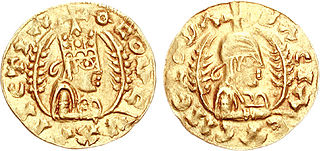
Nezool was a king of the Kingdom of Aksum. He is primarily known from the coins minted during his reign, where his name also appears as Nezana.
Alla Amidas was a king of the Kingdom of Aksum. He is primarily known from the coins minted during his reign.
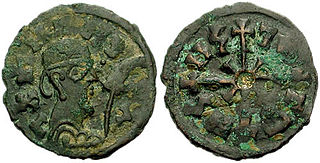
Wazena was a King of the Kingdom of Aksum. He is primarily known through the Aksumite currency that was minted during his reign. Without any clear discussion, Stuart Munro-Hay identifies him with a king Alla Amidas, who is also known only through the coins he issued.
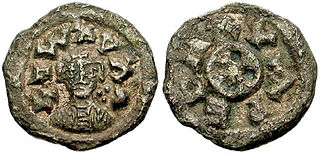
Ioel, or Joel, was a king of the Kingdom of Aksum. He is primarily known through the coins that were minted during his reign. He is one of several Aksumite kings with a Biblical name, the others include Israel, Kaleb, and likely Gersem and Noe; Ioel is named for the Biblical prophet, Joel, author of the Book of Joel.

Hataz was a king of the Kingdom of Aksum. He is primarily known through the coins that were minted during his reign, some of which call him Iathlia. His gold coin calls him Hethasas.
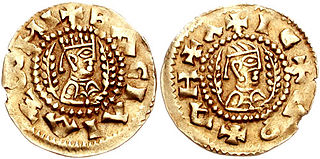
Israel was a king of Axum. He is primarily known through the coins minted during his reign. He is one of several Aksumite kings with a Biblical name, the others include Ioel, Kaleb, Gersem, and likely Noe; Richard Pankhurst mentions the name of this king as an early example of Judaic influence in Ethiopian culture.

Gersem was a King of the Kingdom of Aksum in Northeast Africa. He is primarily known through the Aksumite currency that was minted during his reign.
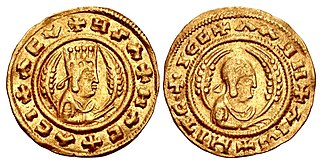
Aksumite currency was coinage produced and used within the Kingdom of Aksum centered in present-day Eritrea and Ethiopia. Its mintages were issued and circulated from the reign of King Endubis around AD 270 until it began its decline in the first half of the 7th century where they started using Dinar along with most parts of the Middle East. During the succeeding medieval period, Mogadishu currency, minted by the Sultanate of Mogadishu, was the most widely circulated currency in the eastern and southern parts of the Horn of Africa from the start of the 12th century.
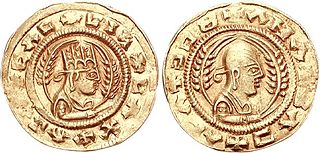
The Kingdom of Aksum (Ge'ez: አኵስም ʾÄkʷəsəm; Sabaic: 𐩱𐩫𐩪𐩣ʾKS1M; Ancient Greek: Ἀξωμίτης Axōmítēs), also known as the Kingdom of Axum, or the Aksumite Empire, was a kingdom in East Africa and South Arabia from Classical antiquity to the Middle Ages. Based in what is now Northern Ethiopia and Eritrea, and spanning present day Djibouti and Sudan, it extended at its height into much of Southern Arabia during the reign of Kaleb, King of Axum.
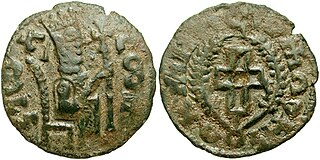
Armah was a king of the Aksum. He is primarily known through the coins that were minted during his reign. While some scholars have suggested as long ago as 1895 that he was identical to Najashi, the king of Axum who gave shelter to Muslim emigrants around 615-6, more recently Wolfgang Hahn has suggested Armah might have been the name of one of the sons of Kaleb, Alla Amidas.
Tchika-Beret or Chiqa Beret is the ruins of an ancient Christian settlement dating back to the Aksumite period lying just 10 km south east of Kombolcha, on the outskirts of Ancharo. The area most notably possesses the Geta Lion Statue, a stone sculpture of a lion's head on the top of a hill that dates back to the early 4th century.

















